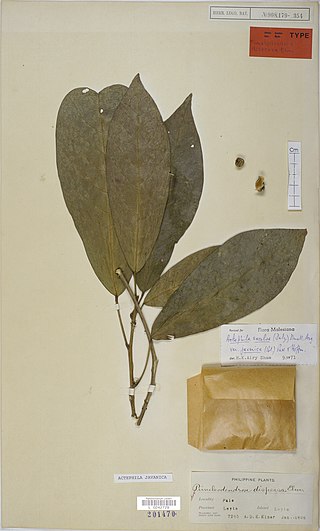
Stachys is a genus of plants, one of the largest in the mint family Lamiaceae. Estimates of the number of species vary from about 300, to about 450. Stachys is in the subfamily Lamioideae and its type species is Stachys sylvatica. The precise extent of the genus and its relationship to other genera in the subfamily are poorly known.

Phyllanthaceae is a family of flowering plants in the eudicot order Malpighiales. It is most closely related to the family Picrodendraceae.

Leucopogon is a genus of about 150-160 species of shrubs or small trees in the family Ericaceae, in the section of that family formerly treated as the separate family Epacridaceae. They are native to Australia, New Zealand, New Caledonia, the western Pacific Islands and Malaysia, with the greatest species diversity in the south-west of Western Australia. Plants in this genus have leaves with a few more or less parallel veins, and tube-shaped flowers usually with a white beard inside.

Leptopus, the maidenbushes, are a genus of plants in the family Phyllanthaceae native to southern Asia from the Caucasus east to China and Maluku. The plants are monoecious herbs and shrubs with simple, entire leaves and small, green flowers.

Beyeria is a genus of shrubs and small trees in the family Euphorbiaceae known as turpentine bushes. It was first described as a genus in 1844. The entire genus is endemic to Australia.
Andrachne is a genus of flowering plants in the family Phyllanthaceae described by Linnaeus in 1753. It is one of eight genera in the tribe Poranthereae.
Meineckia is a genus of flowering plants in the family Phyllanthaceae first described as a genus in 1858.

Actephila is a genus of plants in the family Phyllanthaceae, first described as a genus in 1826. It is one of 8 genera in the tribe Poranthereae, and is most closely related to Leptopus. The name of the genus is derived from two Greek words, akte, "the seashore", and philos, "loving". It refers to a coastal habitat.

Persoonia, commonly known as geebungs or snottygobbles, is a genus of about one hundred species of flowering plants in the family Proteaceae. Plants in the genus Persoonia are shrubs or small trees usually with smooth bark, simple leaves and usually yellow flowers arranged along a raceme, each flower with a leaf or scale leaf at the base. The fruit is a drupe.

Kunzea is a genus of plants in the family Myrtaceae and is endemic to Australasia. They are shrubs, sometimes small trees and usually have small, crowded, rather aromatic leaves. The flowers are similar to those of plants in the genus Leptospermum but differ in having stamens that are longer than the petals. Most kunzeas are endemic to Western Australia but a few occur in eastern Australia and a few are found in New Zealand. The taxonomy of the genus is not settled and is complicated by the existence of a number of hybrids.

Philotheca is a genus of about fifty species of flowering plants in the family Rutaceae. Plants in this genus are shrubs with simple leaves arranged alternately along the stems, flowers that usually have five sepals, five petals and ten stamens that curve inwards over the ovary. All species are endemic to Australia and there are species in every state, but not the Northern Territory.

Ricinocarpos is a genus of evergreen flowering plants in the family Euphorbiaceae and is endemic to Australia. Plants in the genus Ricinocarpos are monoecious shrubs with leaves arranged alternately along the branches, the edges curved downwards or rolled under. Male flowers are arranged singly or in racemes at the ends of branchlets, with four to six sepals that are fused at the base. There are four to six petals that are longer than the sepals, with many stamens fused to form a central column. Female flowers are arranged singly and are similar to male flowers but with three styles fused at the base and with a deeply branched tip. The fruit is a capsule containing seeds with an elaiosome.

Cryptandra is a genus of flowering plants family Rhamnaceae and is endemic to Australia. Most plants in the genus Cryptandra are spiny, heath-like shrubs with small, clustered leaves and flowers crowded at the ends of branches, the flowers are usually small, surrounded by brown bracts, and with tube-shaped hypanthium, the petals hooded over the anthers.

Psydrax is a genus of flowering plants in the family Rubiaceae. It consists of trees, shrubs, and a few lianas in the paleotropics.

Rondeletia is a genus of flowering plants in the family Rubiaceae. It is endemic to the Neotropics. There are around 160 species.

Styphelia is a genus of shrubs in the family Ericaceae, native from Indo-China through the Pacific to Australia. Most have minute or small leaves with a sharp tip, single, tube-shaped flowers arranged in leaf axils and with the ends of the petals rolled back with hairs in the inside of the tube.
Poranthereae is a tribe in the plant family Phyllanthaceae. It is one of ten tribes in the family, and one of four tribes in the subfamily Phyllanthoideae. Poranthereae comprises about 111 species, distributed into eight genera. The largest genera and the number of species in each are Actephila (31), Meineckia (30), and Andrachne (22).














